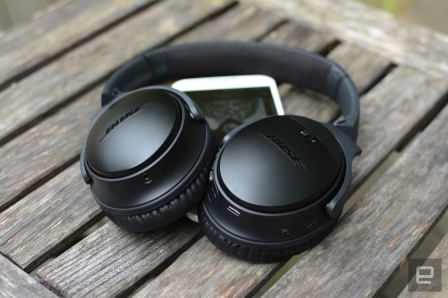Bose’s best headphones are even better wireless
When it comes to headphones, it can sometimes be easy to forget about Bose. The company doesn’t debut new models as frequently as the competition, choosing instead to focus on quality, comfort and its highly touted noise-canceling tech. Bose’s previous noise-canceling model, the QC25, has been around awhile, and despite its popularity, there was one thing missing: a wireless edition. Announced just over a week ago, the QuietComfort 35s mix that trademark sound and feel in a $350 package. I spent a few days using the headphones to see if they met my high expectations.
Gallery: Bose QuietComfort 35 wireless headphones | 20 Photos
Let’s start with the aesthetics. Unlike rivals such as Beats and SMS Audio, Bose never attempted to win us over with fashion. And it doesn’t really need to, given its knack for a comfortable fit and external noise blocking. These new QuietComfort 35s have a design similar to that of their predecessor, the QC25, except they come in all black (pictured) or silver. Personally, I prefer the more sophisticated solid color scheme over the previous two-tone look. It’s a subtle change, but an improvement nonetheless.
All of the controls are on the right ear cup, with a power slider on the outside shell that doubles as a Bluetooth pairing button. Along the rim, there are volume controls and a play/pause key beside LED indicators that let you know when the headphones are paired and when the battery is running low. A double click on the play/pause button will skip ahead to the next track, while a triple click will go back to the previous song. Typically these controls are scattered across individual buttons, which are sometimes on the outside panel of the ear cup. Bose has assigned them to a single control, and honestly, it’s a much better solution.
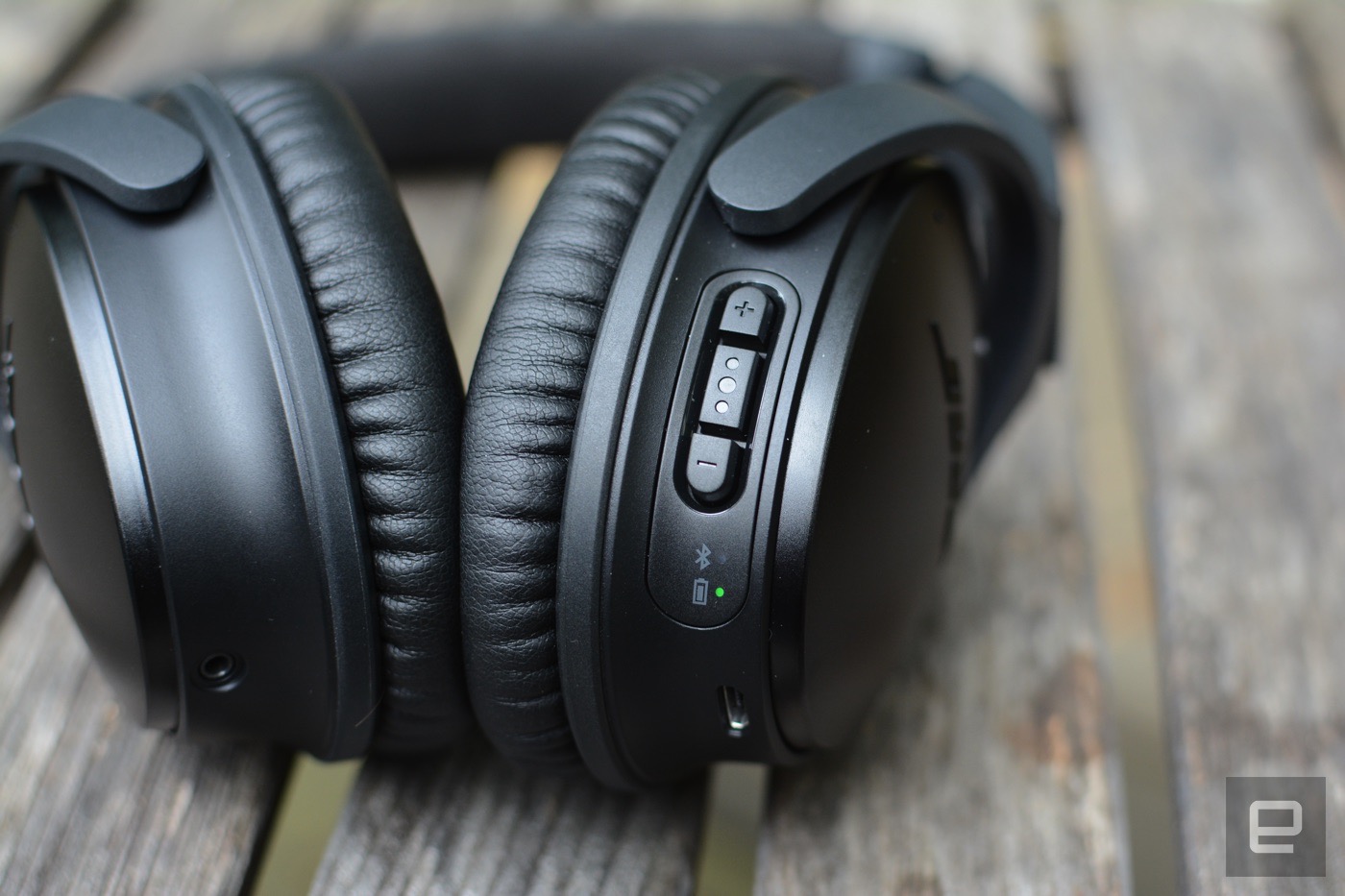
The QC35s are made of glass-filled nylon with a leather outer headband and ear pads. The frame may look like plastic, but Bose says otherwise, and the nylon is advertised to be more durable than regular plastic, too. There’s also a matte finish, which helps the headphones to not look cheap. Bose’s choice to go with nylon also keeps things lightweight — something I’ll address more in a moment.
The inside of the headband is actually made from Alcantara, a softer material used in luxury car interiors. The ear pads are soft and cushy but provide enough insulation between your head and the rim of the ear cup to keep things nice and comfy, even during long listening sessions. In addition to folding in for easy stowage in the included case, the ear cups themselves also rotate to sit flat — a common feature for headphones these days.
In terms of the overall weight, Bose nailed it. These are the first headphones I can remember using that didn’t cause at least some type of discomfort after an hour or so of continuous listening. The combination of the weight, along with the tension of the headband, keeps things super comfortable, and the QC35s never felt like they were pinching my head. It’s easy to understand why Bose’s gear is a top choice among frequent fliers.
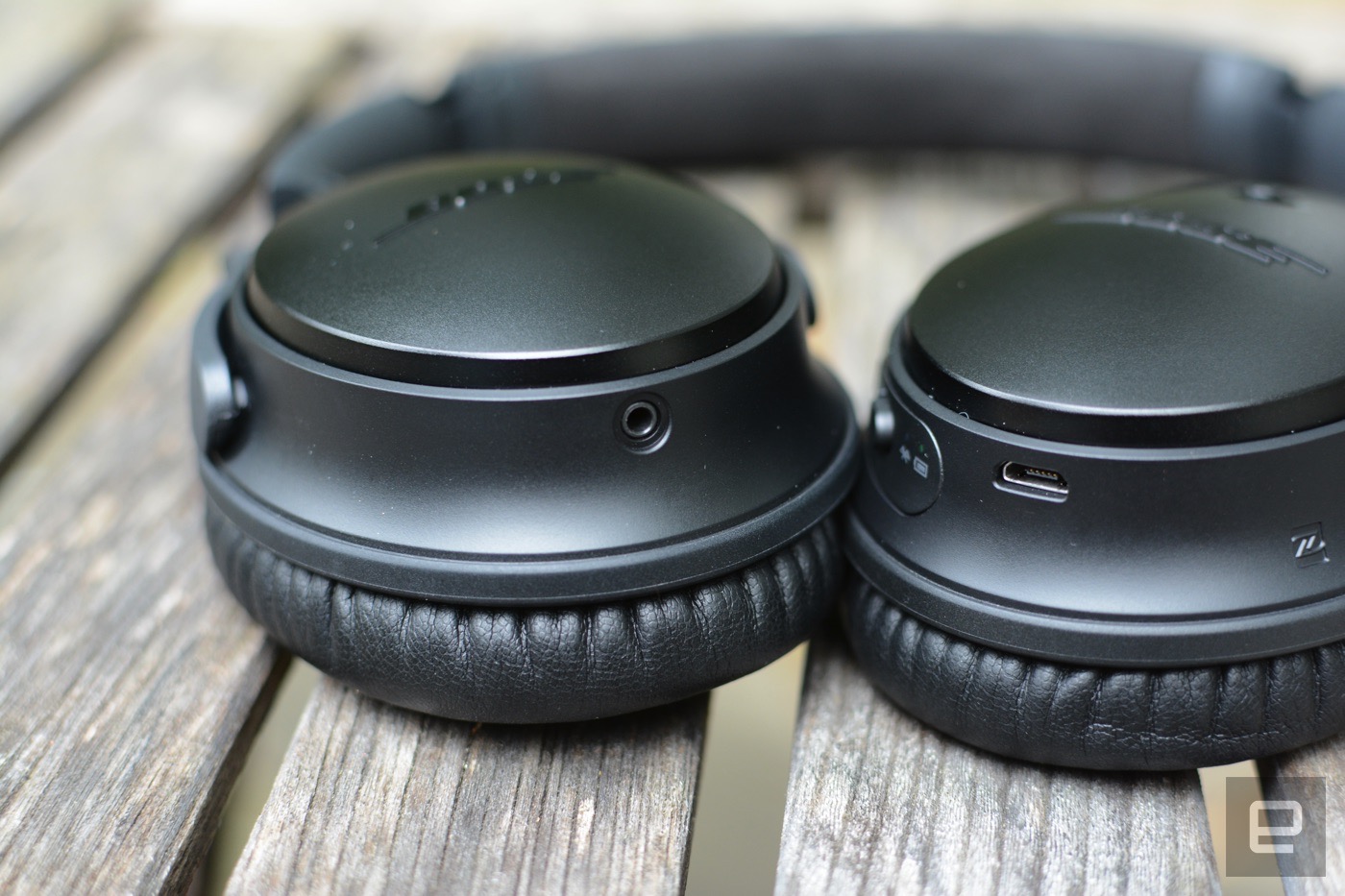
When it comes to pairing a Bluetooth speaker or headphones with a mobile device or laptop, it’s not uncommon to have to try a few times. There are exceptions, but for me, pairing a device rarely happens on the first try. That wasn’t the case here, though: I had no trouble linking the QC35s with my MacBook Air and Moto X. The ability to get everything up and running in a matter of seconds is always a good thing. If you prefer to make the connection via NFC, the QC35s support that as well. Once paired, the Quiet Comfort 35s will let you know how much battery is left, as well as announce which device you’re connected to. For example, you’ll hear “Now connected to ‘Billy’s MacBook Air'” or some such. You can turn off the voice prompts if you prefer, but I appreciated getting an update on the power level.
What about using these headphones for in-flight entertainment? The company isn’t leaving travelers without a way to tap into the music and TV an airline offers to pass the time. There’s an airline adapter included with the QC35s that plugs into those headphone jacks at your seat. You’ll have to use it wired, but it’s a pretty nice touch, if you ask me.
With the QuietComfort 35s, Bose continues its tradition of solid audio quality. Everything is crisp and clear, with a respectable amount of bass for a well-rounded sound. The low-end tones are nowhere near what’s become the norm on headphones these days (read: overpowering), but there’s still enough bass to give you some thump when a song demands it. The QC35s sounded good across a wide variety of genres, including hip-hop, electronica, bluegrass and metal. At higher volumes, I noticed the headphones favored treble a bit more than at a medium or low level. Some songs showcased this more than others, but when I did notice it, I quickly reached for the volume controls to try and remedy the issue. I didn’t encounter any of the distortion that some others have, even with both my phone and the headphones cranked all the way up.
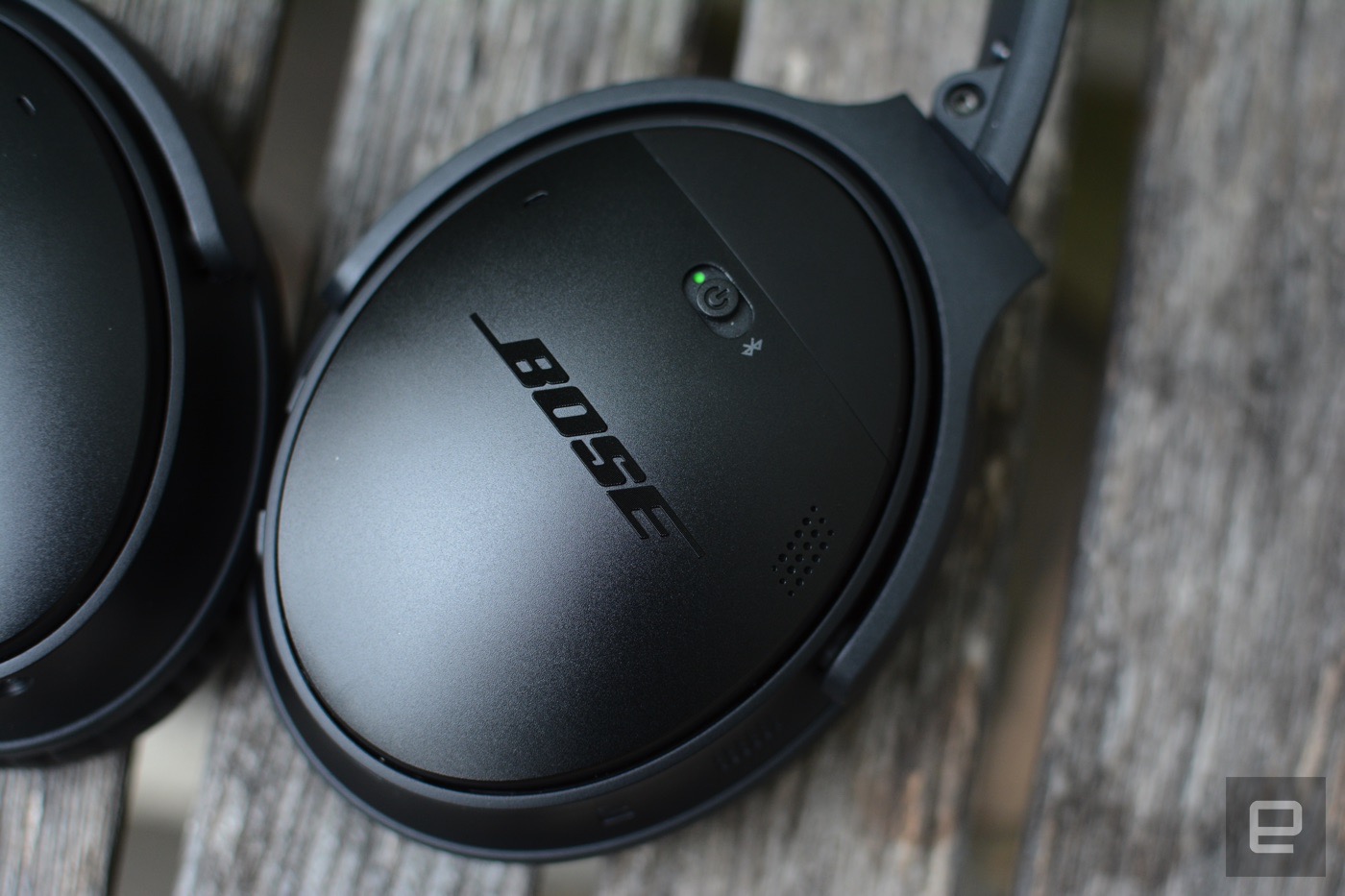
Speaking of volume, the QuietComfort 35 is a strong performer. Sometimes wireless headphones and earbuds just aren’t loud enough for most people to like to listen to at near-deafening levels. I’m happy to report that these headphones are an exception; they get pretty loud. Thankfully, they stop short of painful, so unless you’ve already suffered some hearing loss, I doubt you’ll take issue with the volume here.
Bose promises 20 hours of battery life in wireless mode, and that’s with noise canceling enabled. I actually got a bit more time out of them. I needed a charge after about a week of using the headphones for about three to four hours a day. In wired mode, you can expect battery life to double, even with noise canceling turned on. When you do run out of juice, though, the QC35s will function just fine as a passive set.
The only real gripe I had with battery life is that the headphones don’t turn off automatically, or at least I thought they didn’t. I left them on overnight by accident and they were still on the next morning when I woke up. I didn’t realize at the time that the Bose Connect app (iOS and Android) allows you to switch on an “Auto Power-Down” feature to save your battery when you forget to shut them off yourself. That time can be as little as five minutes or as long as three hours. By default, that feature is disabled, hence my overnight battery drain. The app also lets you manage connected devices, tweak settings and download any updates.
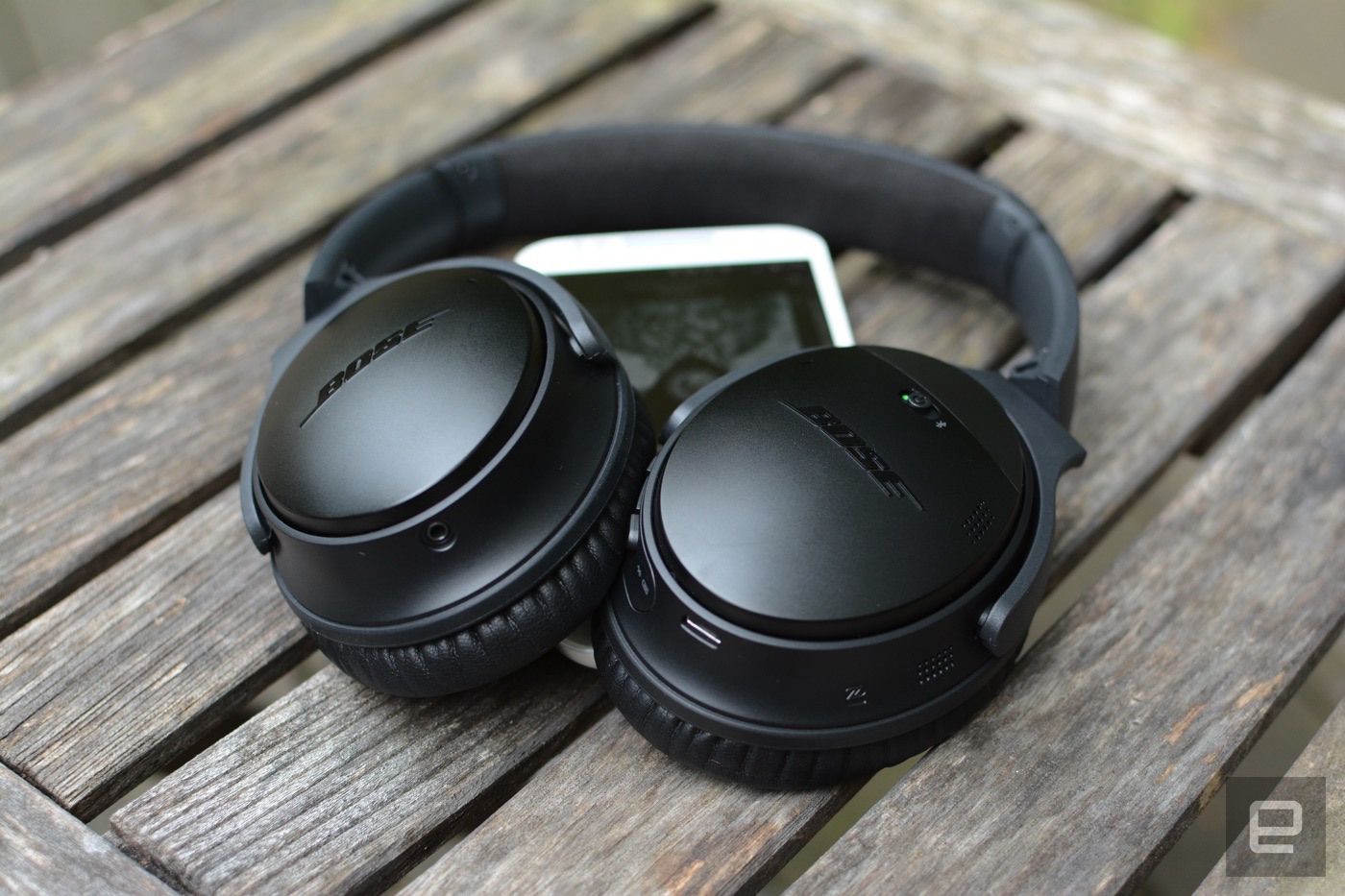
With the Bose QuietComfort 35, the company finally caters to those who’ve been clamoring for a wireless version of its popular noise-canceling headphones. Faithful fans of the brand won’t be disappointed either: The company’s trademark noise cancellation, crisp audio quality and comfortable fit make these some of the best wireless headphones I’ve tested. Sure, they don’t have a flashy design, but they do their job, and they do it well for at least 20 hours on a charge. Perhaps the only surprise here is that Bose set the price at $350, just $50 more than the wired QuietComfort model. That’s on par with other sets, which is really just the bow around a rather stellar package. My expectations for the QC35s were high, and Bose managed to exceed them with another great product.
Update: This post originally stated that the included adapter was a wireless dongle for use on an airplane. It’s actually only for wired use with a 3.5mm cable. The text has been updated to correct the error.
(39)

